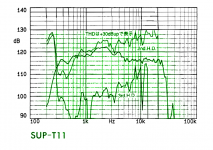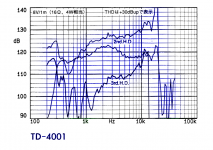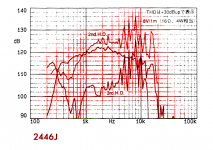Well, I guess I could of picked something worse than the Axi2050, theres a chance that its extension is beyond that of the BE.
Mount it to the 2386 (first), you may be pleasantly surprised.
The Sony SUP T-11 - Alu dia molded to a Titanium surround - went out to 24k without nasty breakup artefacts. Later, an improved version of the T-11 was introduced, which was even better.
Nowadays GT-Sound sells their own, much improved driver, based on the SUP T-11. Only $8000 each.
Check their website, which they have finally updated as well.
You can't tune a fish... The break-up modes are material inherent, espeacially pronounced for large diameters.
I do not believe anything what you have written: "without nasty breakup artefacts" until I see a high-res frequency response und reliable distortion graph at least up to 20k for 2nd harmonic.
What do you make of the Strauss implementation at 400hz?
the friend that inspired the question, says this
2380 and 400hz is crazy. I've used a few drivers including phenolic jbl 2485 and CLS M200's in that horn and 800 is the lowest I'd use it with 4th order high pass. The 2386 is better and can be used to 500 but 800 is better. 2386 sounds better (throat problems in 2380) if you can use a narrow pattern.
No hard data, but a comparison of the Sony SUP-T11 to other 4" dia drivers, including the TD4001, with quotes from the prestigious MJ magazine.
Last edited:
If you search the Japanese sites, you'll find measurements. I've seen some and remember the Sony/GT-Sound drivers compared favorably to the TAD 4001 and JBL 475 (Be). If you are familiar with Japanese culture and more specifically engineering, you know that they don't just claim anything.
Last edited:
Asian esoteric manufacturers build their stuff to extremely high standards. This also includes the use of exotic materials and production techniques, hence the extreme pricing. You can't compare mass produced PA drivers to these. If you want something to compare, take a WE or G.I.P. 594a.
In the end it's also a matter of choice, or preference. I would never spend > 8k on a driver, no matter how good.
Other examples from the past: Onken, Coral, YL and the (mass produced) large format Yamaha 6681A driver that was also used by Meyer Sound (MS-1401A).
Last edited:
Sony SUP-T11...
Here you are: in attachment, three measurements of three competing compression drivers, respectively
- Sony SUP-T11 (Al dia)
- TAD TD-4001 (Be dia)
- JBL 2446J (Ti dia)
all driven with the same voltage (8V, corresponding to 4W on the drivers' nominal 16Ohm impedance), and all measured at 1m on the same horn (Yamamoto SS-300).
The Sony's distortion (2nd and 3rd harmonics) is actually LOWER than that of the Be-equipped TAD!
And if you want to see some nasty break-up... just look at the JBL!
Marco
You can't tune a fish... The break-up modes are material inherent, espeacially pronounced for large diameters.
I do not believe anything what you have written: "without nasty breakup artefacts" until I see a high-res frequency response und reliable distortion graph at least up to 20k for 2nd harmonic.
Here you are: in attachment, three measurements of three competing compression drivers, respectively
- Sony SUP-T11 (Al dia)
- TAD TD-4001 (Be dia)
- JBL 2446J (Ti dia)
all driven with the same voltage (8V, corresponding to 4W on the drivers' nominal 16Ohm impedance), and all measured at 1m on the same horn (Yamamoto SS-300).
The Sony's distortion (2nd and 3rd harmonics) is actually LOWER than that of the Be-equipped TAD!
And if you want to see some nasty break-up... just look at the JBL!
Marco
Attachments
Here you are: in attachment, three measurements of three competing compression drivers, respectively
- Sony SUP-T11 (Al dia)
- TAD TD-4001 (Be dia)
- JBL 2446J (Ti dia)
all driven with the same voltage (8V, corresponding to 4W on the drivers' nominal 16Ohm impedance), and all measured at 1m on the same horn (Yamamoto SS-300).
The Sony's distortion (2nd and 3rd harmonics) is actually LOWER than that of the Be-equipped TAD!
And if you want to see some nasty break-up... just look at the JBL!
Marco
I would say that this is simply not possible that AL outperforms Be at HF. In this case the driver was overdriven or defect.
Again, I cannot take much out of these graphs. 2nd order is above the fundamental?? JBL has break-up modes starting in the mid-range?? This only points more to a bad measuement setup / parameters.
A large format AL driver will have break-up modes. This is simply related to physics and the material properties. You cannot foul the physics.
With respect to distortion measurements you need at least a 48ppo or better 96ppo measurement between 10k and 20k. A very god microphone like Earthworks M23 or M30 and a very good signal chain. I can show you graphs of the newly tested 18s ND3N with at first 12ppo distortion measurements and I was surprised how fairly good this looked between 10k and 20k. Then I repeated with 48 ppo between 10k and 20k and all nasty things got visible. Do not believe into graphs that you have not done and verified yourself ;-)
all this talk of beryllium and aluminum and all i do is keep pinning for old school phenolic (must be starting to lose it...)
all this talk of beryllium and aluminum and all i do is keep pinning for old school phenolic (must be starting to lose it...)
Yea, therefore it would be very interesting to see real measurements of the new FaitalPro HF1440.
Yea, therefore it would be very interesting to see real measurements of the new FaitalPro HF1440.
indeed 🙂
FaitalPRO | HF Drivers | HF1440
or are you talking independent measurement from a third party?
oops seems you need to download the data sheet!
or are you talking independent measurement from a third party?
oops seems you need to download the data sheet!
https://faitalpro.com/en/products/HF_Drivers/product_details/datasheet.php?id=502020185
how similar is keytone polymer to phenolic?
how similar is keytone polymer to phenolic?
FaitalPRO | HF Drivers | HF1440
or are you talking independent measurement from a third party?
oops seems you need to download the data sheet!
The best option is of course my own measurement setup 😉
I do not trust anymore in those datasheets. The curves are most of the time highly smoothed.
I would say that this is simply not possible that AL outperforms Be at HF. In this case the driver was overdriven or defect.
Again, I cannot take much out of these graphs. 2nd order is above the fundamental?? JBL has break-up modes starting in the mid-range?? This only points more to a bad measuement setup / parameters.
A large format AL driver will have break-up modes. This is simply related to physics and the material properties. You cannot foul the physics.
With respect to distortion measurements you need at least a 48ppo or better 96ppo measurement between 10k and 20k. A very god microphone like Earthworks M23 or M30 and a very good signal chain. I can show you graphs of the newly tested 18s ND3N with at first 12ppo distortion measurements and I was surprised how fairly good this looked between 10k and 20k. Then I repeated with 48 ppo between 10k and 20k and all nasty things got visible. Do not believe into graphs that you have not done and verified yourself ;-)
Measurements are not mine. They're from an old issue of MJ (a most reputable Japanese magazine).
All distortion traces are pushed up by 30dB for visibility on the same graph (as clearly indicated).
Make of them what you will.
All I can say is that I have heard the GT Sound systems (which use slightly modified Sony SUP drivers), and IMO they're among the very best out there, bar none.
Over and out.
Marco
Measurements are not mine. They're from an old issue of MJ (a most reputable Japanese magazine).
All distortion traces are pushed up by 30dB for visibility on the same graph (as clearly indicated).
Make of them what you will.
All I can say is that I have heard the GT Sound systems (which use slightly modified Sony SUP drivers), and IMO they're among the very best out there, bar none.
Over and out.
Marco
Marco, I have a scientific education, so please forgive me insisting on numbers 😀
Harmonic distortion does not necessarily mean that the sound must be bad. I have heard arguments that those HF 2nd harmonics sound open and rich. Maybe this is true to some degree because harmonic distortion adds something to the signal that was there before.
Be does not have only advantages. It is light weight and cannot be crossed-over as low as AL or Ti and it cannot withstand as much amplitude. But for home use these points does not count as much as for PA applications.
https://faitalpro.com/en/products/HF_Drivers/product_details/datasheet.php?id=502020185
how similar is keytone polymer to phenolic?
It's like asking what's the difference of a modern space craft to a Ford Model T😉 As phenolic goes, it uses formaldehyde as catalyser

Further on, which compound of the material is in question: Properties of Polyetherketones
PEEK has good thermal and physical strength but poor weathering properties. However, each material has it's own strengths and weaknesses, work with the mechanical build accordingly to these parameters and there's light in the end of the tunnel, however, it could be a freight train also😉
As in real life, pick your poison...
- Home
- Loudspeakers
- Multi-Way
- Is it possible to cover the whole spectrum, high SPL, low distortion with a 2-way?


